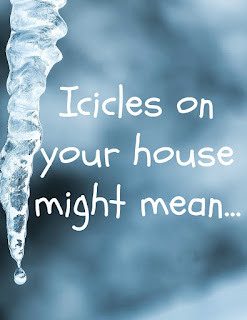When purchasing a property I always recommend a home inspection by a qualified home inspector. Even when a buyer has construction knowledge or a good friend that is a contractor, there is usually something missed, unless they have specific home inspection training.
To ensure to the greatest extent possible the condition of your home purchase have a professional inspector perform a full home inspection. Even with a professional inspector sometimes things are hidden or only occur during certain times of the year, other than the time in which you are purchasing the property.
We won’t go in to inspector qualifications here, but will address one thing that may be a hidden problem depending on when you purchase your home and that is the problem and impact that ice dams may have on a home.
First let’s define a part of the roof on any home called the “Eave”. This is the part of the roof which typically project beyond the exterior wall of the home. Some eaves may be fairly short, others may project some distance over the exterior wall of a home. Eaves allow rain and snow melt to fall from the roof to the ground or into a rain gutter and not run down the side of the structure. Eaves also provide shade for a home.
An eave will not typically have insulation so it will almost always be the coldest part of the roof during winter months. In areas that receive snow, as the snow melts on the warmer part of the roof and runs down the roof when the water hits the eave which is colder, at some point it will usually be cold enough that the water will freeze. As more water runs down, the freezing water, now ice, backs up the roof and may push itself up your roof and under the shingles. As the ice builds up, the ice or water is able to push its way up under the shingles of the roof. The water may then go through any penetration of the tar paper or roof underlayment. Theshovelshack.com has a great photo showing how Ice and Snow cause leaks.
Removing an ice dam once it has formed is difficult and may be very dangerous because getting on the roof and near the area where the ice has formed is icy. I’m sure that is logical so let’s not belabor the danger. If possible the safest way is to use a ladder or boom lift to get to the edge of the roof and attempt to melt or cut a channel so that the water may drain. This is very difficult to do and not damage the roofing material or rain gutter.
As in life, Prevention is the best medicine. There are two problems to deal with, first the cooler eave builds up ice. Second the warmer attic space melts the snow. If you are able to install more insulation in the attic and plug any penetrations so that the attic does not warm up enough to melt the snow that will help the situation. However, many homes with vaulted ceilings are not able to access the cavity once the home is finished and typically the vaulted ‘attic’ space is only the width of the roof joist so the roof is going to heat up.
When a huge snowstorm hits you may have seen on the news people with “roof rake” attempting to remove the snow from the roof to prevent both collapsing of the roof as well as ice dams. The solution which I used on my home is to hire an electrician to install heat tape on my roof above the eave and in my rain gutter. When a storm hits I turn on an electrical switch and the tape heats up preventing the build up of ice over the eave of the home and providing a channel for water to run.
If you are capable of performing this work yourself be aware of the quality of the heat tape. As per my electrician all heat tape is not rated the same and some do-it-yourself kits are not sufficient to provide enough safe heat and may in the end be torn off the roof because of the ice build up.
A couple of more thoughts are to make sure you do a good fall cleaning of your rain gutters. Take care to not have large tree limbs that hang over your roof. Even with heat tape if a limb gets a lot of snow and breaks falling on to your roof it may damage the heat tape.
In summary, if there is no heat tape on a home in a snowy climate and you are purchasing the home in the summer, ask the inspector to do everything possible to inspect the eaves and attic space as much as possible, especially at roof valleys, to determine if there has been any water damage from an ice dam.



